Icons: Mick Guzauski on Engineering and Mixing Daft Punk’s “Random Access Memories”
Talk about being in the right place at the right time.
No, we don’t mean the moment Mick Guzauski got invited to engineer and mix the new chart-topping album by Daft Punk, Random Access Memories. We mean the countless sessions that the Grammy-winning audio pro worked setting up mics and capturing sounds since beginning his career in 1970. His CV as an audio engineer is impressive enough — it includes Chuck Mangione, Prince, Barbra Streisand, The Motels, Johnny Mathis, Stanley Clarke, Deniece Williams, Patti Labelle, Commodores, Michael McDonald, The Pointer Sisters, Dionne Warwick, Kenny Rogers, and Gladys Knight & the Pips, among many more.
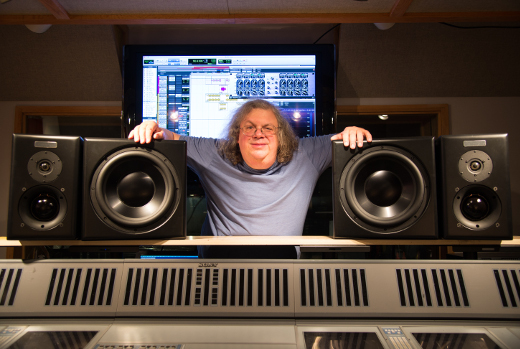
Mick Guzauski, together with his Guzauski-Swist GS-3a monitors at his NY home base, Barking Doctor Recording. (Photo credit: Ellen Guzauski)
When Daft Punk started looking for an engineer/mixer to team up with on their fourth studio album – and first in eight years – the recommendation of mutual friend Chris Caswell, the album’s keyboardist and arranger, led them to Guzauski. The duo of Thomas Bangalter and Guy-Manuel de Homem-Christo got excited when they hopped online and saw his huge, genre-spanning credit list of rock, funk, soul, R&B, pop, classical and more. What’s more, Guzauski’s credits in the dual role of engineer/mixer contains Michael Jackson, Prince, The Temptations, Earth Wind and Fire, Chuck Mangione, Natalie Cole, Kenny G, and Christina Aguilera.
But Daft Punk probably really had to come up for air when they added up mixing credits for the upstate NY-based Guzauski, which started in 1970 and then took off hugely in the late ‘90’s, with Guzauski serving as the go-to mix guy for Doc Sevrinsen, Michael Jackson, Julio Iglesias, Stevie Nicks, Sparks, Neil Diamond, Talking Heads, George Benson, Boz Scaggs, Kiss Whitney Houston, Mariah Carey, Vanessa Williams, Derek and the Dominoes (5.1 mix), Steve Perry, Luther Vandross, Michael Bolton, Jessica Simpson, Ricky Martin, Pavarotti, Eric Clapton, Jennifer Lopez, Backstreet Boys, Boyz II Men, Christina Aguilera, Toni Braxton, B.B. King, En Vogue, Brian McKnight, Gloria Estefan, Andrew Lloyd Webber, Cream, *NSYNC, Cher, Bette Midler, Chick Corea, Alan Menken, Celine Dion, and Britney Spears.
The incredible depth of the gregarious engineer/mixer’s experience mattered a lot to Daft Punk, who were out to make a genre-hopping journey of their own with the enthusiastically-received Random Access Memories, projected by Billboard to hit #1 this week. Their Grammy-winning electronic music career began with the 1997 album Homework, and has since produced three more studio albums spawning smashes like “Harder Better Faster Stronger” and “Technologic,” in addition to their 2010 score for Tron: Legacy.
Based out of the Larry Swist-designed Barking Doctor Studio, where a Sony OXF-R3 Oxford console holds center court, Guzauski was actually only vaguely familiar with Daft Punk’s work when the band came calling in 2011. But he was thrilled with the opportunity to flex his full engineering chops again, tasked as he was with recording all the basic tracks and select overdubs, plus mixing – all at the legendary Conway Recording in Los Angeles. A 1972-born studio, Conway’s live room was the perfect tracking space for Daft Punk and their hand-picked live band, while the Neve 88R-equipped Studio C proved an ideal mix HQ for Guzauski.
The results that Daft Punk, their long list of all-star musical collaborators (Panda Bear, Julian Casablancas, Todd Edwards, DJ Falcon, Chilly Gonzales, Giorgio Moroder, Nile Rodgers, Paul Williams, and Pharrell Williams), Guzauski, and the elite engineering staff achieved with Random Access Memories speak for themselves.
A 13-track trip through music and time, the album is vibey, visual, far-reaching, and yet remarkably even-tempered throughout. The magical intro and groovy restraint of the opener “Give Life Back to Music” smoothly sets up the masterfully sublime “The Game of Love.” “Giorgio by Moroder” is an entrancing documentary in a song, while the funky restraint of “Lose Yourself to Dance” directly precedes the oceanic hugeness of “Touch,” Daft Punk’s collaboration with Paul Williams. The Pharrell Williams colab “Get Lucky” is already a huge #1 single, and a massive triumph for Nile Rodgers, whose smooth-voice-leading guitar line is an outstandingly satisfying disco dish.
“Beyond” is just cinematic in scope at the beginning, before it gives way to a 1 AM buzzed chillout, with a terrific live drum backdrop that’s just delicious for organic rhythm lovers. The song “Motherboard” is a classical surreal hybrid and a true refresher for the ears, despite having so much going on. “Doin’ It Right” digs deeper into other-wordly funk, and “Contact” is a grand, all enveloping closer, complete with interstellar static and a true drums-and-synth-machine jam.
With mixes currently on his plate for Michael Bolton and Paul Anka, Guzauski was able to take a few minutes away from the Oxford and discuss his extremely unique experience: engineering and mixing Daft Punk’s Random Access Memories.
How did you originally get involved with the making of “Random Access Memories”?
A good friend of mine, the keyboard player/arranger Chris Caswell, got involved with them working on the Tron soundtrack, and he was working with them again on Random Access Memories playing piano, Rhodes, arranging and being a music director.
They asked him for an engineer that was familiar with all types of music – basically an old fart like me that had worked with bands and studio players, as well as modern stuff. They Googled me and said, “Yeah let’s get this guy!” So that’s what happened.
What was your reaction when you got the call from Daft Punk?
I had heard what their other albums were like, and I thought, “This is really cool, but why are they calling me?” I didn’t have a lot of experience in electronica. Then we talked, and they said they wanted a retro album going back to ‘70’s disco, with all live players. The idea was electronica based on live performances. I thought, “This is going to be great,” and I got excited.
What impressions of Daft Punk did you form while you were preparing to do the engineering for the album – how did that inform your plan?
I really didn’t try to preconceive any ideas about it, because I knew this one was going to be different from anything they had done before.
How long did the recording take, and where was it done?
We had a meeting first, and they had what they wanted to do sketched out. The songs weren’t fully realized, but they had a lot of ideas down in Pro Tools, ideas for the band to play with.
Then we went into Conway Recording’s Studio C, and we were there for two weeks tracking drums, bass, percussion and keyboards. We had two rhythm sections: one with John “JR” Robinson on drums and Nathan East on bass for a lot of songs, and then Omar Hakim on drums and James Genus from the Saturday Night Live band. The percussion player, Quinn, was incredible, and Chris Caswell was on keyboards (see the complete list of players here). Then we went to Capitol Studios and recorded the orchestra for two days.
How was Conway Recording selected — what was right about tracking Random Access Memories there?
That’s where I did most of my work mixing and tracking in the ‘80’s and early ‘90’s when I lived in LA. Daft Punk had some specific things they wanted to do, include using a Neve console, which I love. They have a newer one, an 88R in Studio C, and we also went for C because it was a bigger room, with more space to spread out. The guys fell in love with Studio C, which is where we did all the basic tracks, and mixed too.
Studio C is also really nice because they have two nice-sized ISO booths – we could do acoustic piano and drums at the same time, for example, with no leakage. It gave us a lot of flexibility.
What were the specific instruments you tracked, and overdubbed?
We tracked drums, bass, Fender Rhodes, acoustic piano where that was used, and sometimes some synths live. The overdubs in Conway were mostly percussion. Quinn has a lot of self-built drums and instruments – all that psychedelic stuff you hear in the beginning of the song “Motherboard,” for instance, is actually all percussion. This guy had an amazing sound. We worked with him for three or four days in Studio C which I’d say is 28 feet wide by almost 50 feet long, and it was completely filled with his percussion stuff.
How did the band direct you through the tracking? What kind of sounds were you going for?
They just wanted the sound to be very natural. Think 1970’s when things were not very processed, but think hi-fi too – modern quality, but natural sounds. The drums we tracked were baffled off. Studio C is fairly live, but we also had room mics. We could get tight sounds if we wanted, but also use the room.
At this point in the project, I didn’t know what was going where, so I wanted to track with the flexibility of using different acoustic perspectives later on. Most of the drums are dry and tight for the dance songs, but for parts of “Touch” it’s almost all room. We tried to record with versatility in mind.
What were some of the mic choices you made on the drums?
The kick drum we used an AKG D112 and Sony C500 right next to each other inside the drum, with a Neumann U 47 FET outside of the drum, and a Yamaha NS10 woofer as a sub. Those four mics were on four separate tracks, so we could dial in the kick drum sound that we wanted.
The snare was a Shure SM57 on top, AKG C451 on the snare bottom, AKG C451 on high hat, Sennheiser MD421’s on toms, the overhead was a pair of Schoeps CM5U’s, and we used a pair of Neumann U 87’s for the room.
We always went for positioning. We didn’t use a tremendous amount of EQ, but really tried to get most of the sound with mic placement.
When it came to piano, what was your miking approach?
On Conway’s nine-foot Yamaha, we used a pair of DPA’s over and a bit behind the hammers – dividing the keyboards into thirds – at about 15-inch height, and a U 67 back over where the bass strings cross. The DPA’s were mixed left and right, the U 67 filled in the center.
How about vocals?
I didn’t record a lot of the vocals – the band mostly went to where the singers were and recorded them there. I did record Paul Williams for “Touch” using a U 67, and for “Fragments of Time” I recorded Todd Edwards with a U 47. On both of those vocals I used a Neve 1073 preamp/EQ, and an LA 2A compressor.
Everything on this album was recorded to Pro Tools running at 96 kHz, with Lynx Aurora converters and Antelope clock.
We simultaneously recorded the basic tracks – drums, bass, and keyboards – to an A827 Studer tape machine with Dolby SR running at 15 inches per second (ips), and then we transferred that to Pro Tools. So we had tracks that were recorded directly to Pro Tools, and tracks to analog tape, which meant that we had choices on a song by song or part by part basis. Usually for the dance stuff they went with the digital because it was punchier, but in other places they wanted a warmer, less transient sound, so there we would use the analog recordings.
When we were actually tracking, it was all the skeleton of things. I didn’t know what the songs were going to be. They had it in their heads, but a lot of the songs were arranged in editing. That’s one of the other brilliant things about Daft Punk – Thomas is a virtuoso in Pro Tools.
Was it disorienting at all for you to not know exactly where the songs were headed as you tracked them?
Not really, because we knew what the vibe was going to be.
After the basic tracks were recorded, they took the Pro Tools files back to France, started editing, and truly realized the songs’ structures. Then they came back to LA, we did a bunch of guitar, keyboard and percussion overdubs for about two weeks. From there they went back to France for months more of editing and recording, and then they came back to LA to mix.
They set up a separate Pro Tools room, editing the tracks as I was mixing them, and sort of finessing their parts – updating them as I was mixing. It was a very interactive process.
What did you like about Conway’s Studio C for mixing? Tell us about the board, monitors, layout – and anything you did to “personalize” it for yourself.
Well, we used my own monitors throughout this whole project, the Guzauski Swist GS-3a. We used those for tracking, then the Daft Punk guys bought a pair and they have them in Paris, so they did most of their work on them.
I brought them to the orchestra sessions, and then we also used them for the two weeks of overdubs. We also used them at Conway for mixing. Pretty much everything I was involved in and what Daft Punk did alone was monitored on those speakers.
You personally designed the GS-3a along with Larry Swist. After several years of working on your own monitors, what are your impressions of them now?
They’re small enough to be used as nearfields, and they also sound exciting during tracking. They have a very wide, flat response without having to use an additional subwoofer – they’re flat from 30 Hz on up, with very low distortion. Larry designed a decoupling mount for the midrange and high frequency drivers. This prevents the low frequency energy from the woofer from superimposing on the higher frequency waves, which lowers intermodulation distortion.
They’re a nice reference, and we didn’t use any larger or smaller speakers. We took the material out and listened on other things, but in the control room we didn’t use anything else as a reference.
What was the Neve 88R and outboard like for you in Conway’s Studio C?
The Neve 88R is Neve’s newest analog console. Conway was an early adopter of the VR consoles in the mid-80’s, and a tech there named John Musgrave did some nice upgrades on the VR. The 88R is a VR that includes those improvements, and also some others.
It’s a very nice-sounding console, and very versatile too. This console has a 4-band parametric EQ and dynamics section on every channel, and a nice center section. Everything sounds warm and very clean, and it’s a nice console to operate.
As far as outboard gear, this album was mostly analog. Other than recording digitally, most of the processing was analog, which was something specific they wanted and I think it really helped.
We got all sorts of different EQ’s and compressors, and auditioned all sorts of different pieces. We had a bunch of 1176’s which I used a lot, and I listened to specific ones for specific things. Neve 33609’s got used a lot, an API 2500, the Chandler EMI, and the Cranesong. As far as EQ, we had GML, Avalon, API, Neve. Most of our reverb was EMT 140 plates, real ones.
What’s special to you about a real plate reverb?
You have to find a good one first. They’re all different, but when you find a good one, they’re so warm, smooth and spacious sounding. The emulations are nice, and they’re always the same, but the real thing takes a little searching around for, and tweaking, but when you get it there’s nothing like it.
Plus, some of the reverb was Capitol’s live chamber, which is world-renowned. We recorded the orchestra there, and then they also brought some of the vocal tracks back there and recorded the chamber.
How did it inform your mixing to have done most of the basic tracking, and some of the overdubs?
That’s nice because I knew what was there, and it’s easy to treat something when I know what I went for. It speeds up the mixing considerably, since we discussed the sounds and actually got them to tape and Pro Tools.
We didn’t need a lot of drastic EQing. The thing is to do it with mic positioning, and to not do drastic EQs. That’s one of the reasons that people are really liking the sound of this album, because it’s very easy to listen to. Things aren’t twisted all over to work with each other.
I take it Daft Punk attended the mix sessions.
They were around the control room a lot of the time. They’d go into their Pro Tools room, I’d set up a mix, they’d comment on it, and we’d work on it. We would always leave it set up for the next day to finalize it. Some songs took a few days, some were quicker.
We didn’t do any recalls, we just worked on each one until it was right, which was a really nice luxury to have. Because to recall something like that…even though the board has recall, you’re twisting it back. And the outboard has a picture, but you never get it exactly right. So we got it exactly where we wanted. That spot.
We had a really good team, of course. Seth Waldman was our assistant – he was an excellent assistant, a really good engineer in his own right, very knowledgeable and helpful.
Daft Punk has an engineer that was on the whole project, Peter Franco, who was indispensable. He physically engineered stuff, he was a liaison, he kept everybody appraised of what everybody else was doing. He’s a very knowledgeable and talented engineer, and he deserves a lot of credit.
Dan Lerner was their Pro Tools guy. You can imagine how many files there were, and things to keep organized, and not having to think about a lot of that myself was great. Dan was logging all the files, and he knows Pro Tools really well, so he kept it moving smoothly.
And the techs at Conway Recording were great, especially keeping up with the demands on the tape machines. We mixed to three Ampex ATR-102 half-inch tape machines simultaneously: the one at 15 ips had Aria Electronics, one at 30 ips had standard heads, and the other at 30 ips had high-fluxivity heads. They sounded slightly different, and we mixed simultaneously to all three.
Daft Punk listened painstakingly to every take, A/Bing, deciding which character of analog machine best complemented the song. In a lot of cases we’d make different prints on the tapes using the same automation, but with different master fader positions for less and more saturation of the tape. Then they’d pick with print sounded best to them, to master.
Every time we changed a reel, the Conway tech staff checked the recording line of all three machines with an Audio Precision analyzer, to make sure the tape was consistent and that the distortion was low. That was a very painstaking process.
In the mix, what was the vibe you wanted to maintain from song to song?
That it wasn’t overprocessed, and that the sounds were natural, warm, easy to listen to. It offers a really nice contrast between acoustic, warm sounds that aren’t over-compressed or overhyped, and electronic sounds – some of which are warm themselves, while some are more aggressive.
What’s your approach to crafting a dance mix? What makes it really work?
You want to move to it. Of course, it’s in the arranging, but the mix is just keeping the elements that make you move. I had a preconceived notion about a lot of dance mixes, that they’d be expecting drums that are super big and punchy, and everything subservient to that. These guys didn’t want that – they wanted it to be more subtle, nice to listen to, and not beat you up. They really knew exactly what it should be.
How do you apply that specifically to mixing the drums, which are so crucial to a record like Random Access Memories?
It’s the whole thing we’ve been talking about: tracked correctly, not overprocessed, although we did use some parallel compression on occasion to help the drums punch through.
My advice is that the most important thing is balance, and for the sonics of each thing not to get in the way of other elements. You don’t want too much happening in one frequency range, not the same kind of texture and harmonics. But the most important thing is the balance and the inter-relations.
Nile Rodgers’ guitar is so signature on “Get Lucky.” What approach did you take to mixing it? How do you walk the balance between featuring it and not letting it overpower the track?
I just put up his track in the mix, and got the right balance! I experimented with balancing and other positioning, and working other stuff around it. He didn’t have to be processed – Nile just sounded great the way he is.
There are some mini-epic songs here, “Touch” (8:19), “Giorgio” (9:05) – is there a difference in “long-range” mixing for longer experimental songs like this?
It’s something that’s entirely different in every case. You have to know what’s happening in the next section, and what the arc is going to be. You’re mixing something, but you’re conscious of what’s to come, and later on in the song you’re conscious of what passed.
I can’t be more specific than that, because you look at “Touch”, “Giogio”, “Motherboard” – they have a lot of different movements. The common thing in the approach is you have to have the overview of the whole thing, probably more so in those than when mixing several different short songs.
Last question: You weren’t that familiar with Daft Punk before you got onboard with this project. What did you learn about Thomas and Guy as musicians by the time it was done?
They’re very, very creative guys. Visionaries, I think. Daft Punk looks at a long span of musical history and musical future, they exist in several decades at once, and really put it all together. They also really know what people want, and what really strikes people right.
Daft Punk pushed me to things I wouldn’t have done otherwise. Their direction was great, and it pulled me away from preconceived ideas of mixing, by combining newer concepts with older techniques. It was a good experience for me – I came out of this a much better engineer than when I went into it.
— David Weiss
Want more Mick? Don’t miss this new interview with him on Pensado’s Place:
And the Creator’s Project series, The Collaborators, provides even more studio insights from all of Daft Punk’s cohorts — start with this installment featuring Nile Rodgers:
Please note: When you buy products through links on this page, we may earn an affiliate commission.







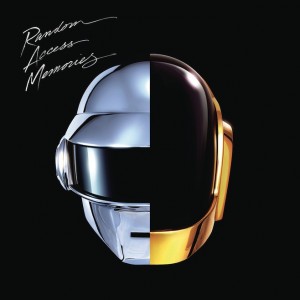
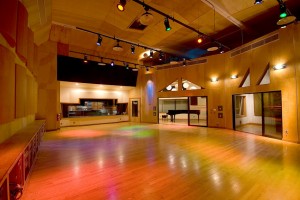
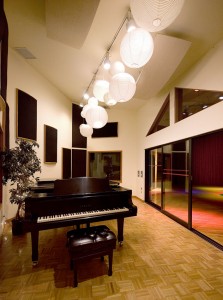
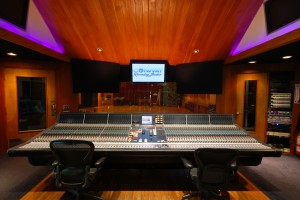
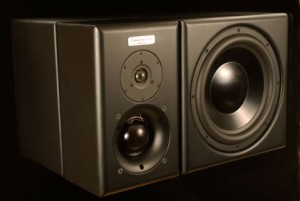
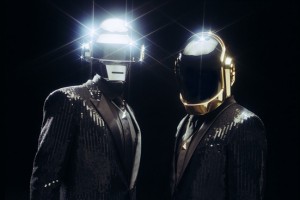
JF_Amadei
May 28, 2013 at 3:17 am (11 years ago)Note that this album is the first studio album of the duo. The 3 previous one were all home made.
Big Don
May 28, 2013 at 7:14 am (11 years ago)Brilliant interview, thank you !
Quinn Drummer
May 28, 2013 at 4:50 pm (11 years ago)THANKS Mick Guzauski for the mention and kind words!! It was such a pleasure to work with you and hope you do it again soon. Congrats to you!! Quinn
Luxxury
May 30, 2013 at 3:29 pm (11 years ago)great article…this man is a legend.
disqus_rfgkvAhgYR
May 31, 2013 at 7:43 am (11 years ago)Well Done Mick! ~ Steve Fix
Plush
June 26, 2013 at 7:07 am (11 years ago)Totally Pro, totally hott. Thank you, Mick and Daft Punk. Music SOUNDS beautiful on this production.